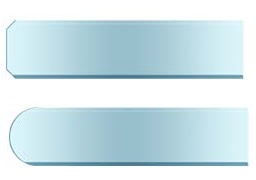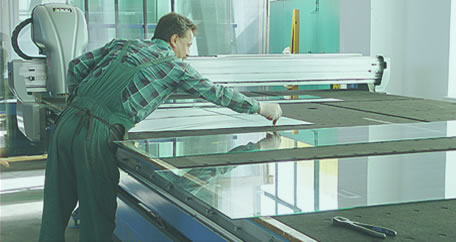BEVELLING
It consist in creating so called wide bevel i.e. refraction of glass surface thanks to which a desired visual effect is achieved. Refracting light makes the glass more aesthetically pleasing.
APPLICATION
Bevelled glass or mirrors are most commonly used as interior design elements e.g. glass tops of coffee tables, shelves, bookcases, partition walls and the like.
WE MAKE
bevels of various widths on
mirrors and glass, bevelling on both sides of the glass
minimum glass dimensions |
60 × 60 mm |
maximum glass dimensions |
2340 × 3210 mm |
maximum width of
bevel at given glass thickness |
glass.............bevel
3 mm.............10 mm
4 mm.............30 mm
5 mm.............40 mm
6-19 mm........45 mm |
POLISHING
We polish 3 mm to 19 mm thick glass in many different ways. Our professional glass processing machines guarantee top quality of our services.
SHAPES OF POLISHED SECTIONS
Glass can be polished to form c-cant (polished section is straight with slightly truncated edges) or pencil edge (polished section shape is similar to the letter C)
c-cant
polished section |
 |
pencil edge
polished section |
FINISH
Polished section can be shiny or matt
ADVANTAGES OF POLISHING
During the glass cutting process there is a possibility of micro-cracks formation on the edges of cut out panes. In order to decrease the chances of cracking as a result of internal stress (which may be the effect of e.g. sun exposure, impact, forced bending etc.), glass undergoes polishing.
One of the basic functions and advantages of polishing is an increase in glass usage safety in those places where a risk of injury appears e.g. frameless door systems, glass tops, walls, shelves etc.
UV BONDING
The process of glass bonding using adhesive cured with UV rays is currently very popular. This method is used for, amongst the others, bonding glass furniture, display cases, shelves, bonding decorative elements to glass or mirror surfaces, attaching hinges to furniture doors or frameless glass doors and attaching metal hardware to glass etc.
UV BONDING
UV bonding is achieved by means of a transparent adhesive cured with UV rays.
ADVANTAGES
The greatest advantage of this method is the fact that the finished bond is transparent – adhesive does not leave any residue. This ensures high attractiveness of manufactured products. Another equally important issue is the fact that the UV bond is very tough, even tougher than the glass itself.
APART FROM THIS:
- Drilling
- Blunting
- Toughening
